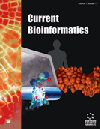- Home
- A-Z Publications
- Current Bioinformatics
- Previous Issues
- Volume 17, Issue 9, 2022
Current Bioinformatics - Volume 17, Issue 9, 2022
Volume 17, Issue 9, 2022
-
-
Microarray Analysis Workflow Based on a Genetic Algorithm to Discover Potential Hub Genes
More LessThis paper presents a sequence of steps oriented to gain biological knowledge from microarray gene expression data. The pipeline's core is a canonical multi-objective Genetic Algorithm (GA), which takes a gene expression matrix and a factor as input. The factor groups samples according to different criteria, e.g., healthy tissue and diseased tissue samples. The result of one run of the GA is a gene set with good properties b Read More
-
-
-
Combining Network-based and Matrix Factorization to Predict Novel Drug-target Interactions: A Case Study Using the Brazilian Natural Chemical Database
More LessBackground: Chemogenomic techniques use mathematical calculations to predict new Drug- Target Interactions (DTIs) based on drugs' chemical and biological information and pharmacological targets. Compared to other structure-based computational methods, they are faster and less expensive. Network analysis and matrix factorization are two practical chemogenomic approaches for predicting DTIs from many drugs Read More
-
-
-
Identification of Plasmodium Secreted Proteins Based on MonoDiKGap and Distance-Based Top-n-Gram Methods
More LessAuthors: Xinyi Liao, Xiaomei Gu and Dejun PengBackground: Many malarial infections are caused by Plasmodium falciparum. Accurate classification of the proteins secreted by the malaria parasite, which are essential for the development of anti-malarial drugs, is necessary. Objective: This study aimed at accurately classifying the proteins secreted by the malaria parasite. Methods: Therefore, in order to improve the accuracy of the prediction of Plasmodium secret Read More
-
-
-
iATC-NFMLP: Identifying Classes of Anatomical Therapeutic Chemicals Based on Drug Networks, Fingerprints, and Multilayer Perceptron
More LessAuthors: Shunrong Tang and Lei ChenBackground: The Anatomical Therapeutic Chemicals (ATC) classification system is a widely accepted drug classification system. It classifies drugs according to the organ or system in which they can operate and their therapeutic, pharmacological, and chemical properties. Assigning drugs into 14 classes in the first level of the system is an essential step to understanding drug properties. Several multi-label classifiers have been Read More
-
-
-
A Tagging SNP Set Method Based on Network Community Partition of Linkage Disequilibrium and Node Centrality
More LessAuthors: Yulin Zhang, Qiang Wan, Xiaochun Cheng, Guangyang Lu, Shudong Wang and Sicheng HeAims: Solving the tagSNP selection problem by network method and reconstructing unknown individual from tagSNPs by a prediction method. Background: As a genetic marker, SNP has been used for linkage analysis of genetic diseases in genome- wide association studies. The genetic information carried by SNPs is redundant in regions of high linkage disequilibrium in the human genome. Therefore, a subset of informa Read More
-
-
-
NeuMF: Predicting Anti-cancer Drug Response Through a Neural Matrix Factorization Model
More LessAuthors: Hui Liu, Jian Yu, Xiangzhi Chen and Lin ZhangBackground: Anti-cancer drug response is urgently required for individualized therapy. Measurements with wet experiments are costly and time-consuming. Artificial intelligence-based models are currently available for predicting drug response but still have challenges in prediction accuracy. Objective: Construct a model to predict drug response values for unknown cell lines and analyze drug potential association properties in Read More
-
-
-
SIMEON: Prediction of Chemical-protein Interaction via Stacked Bi-GRU-normalization Network and External Biomedical Knowledge
More LessAuthors: Xiaolei Ma, Yang Lu, Yinan Lu and Mingyang JiangBackground: Chemical compounds and proteins/genes are an important class of entities in biomedical research, and their interactions play a key role in precision medicine, drug discovery, basic clinical research, and building knowledge bases. Many computational methods have been proposed to identify chemical–protein interactions. However, the majority of these proposed models cannot model long-distance depen Read More
-
-
-
Identification of Key Prognosis-related microRNAs in Early- and Late- Stage Gynecological Cancers Based on TCGA Data
More LessAuthors: Venugopala R. Mekala, Chiang Hui-Shan, Chang Jan-Gowth and Ka-Lok NgBackground: Gynecological cancers (GCs), mainly diagnosed in the late stages of the disease, remain the leading cause of global mortality in women. microRNAs (miRNAs) have been explored as diagnostic and prognostic biomarkers of cancer. Evaluating miRNA signatures to develop prognostic models could be useful in predicting high-risk patients with GC. Specifically, the identification of miRNAs associated with differ Read More
-
-
-
Prediction and Motif Analysis of 2’-O-methylation Using a Hybrid Deep Learning Model from RNA Primary Sequence and Nanopore Signals
More LessAuthors: Shiyang Pan, Yuxin Zhang, Zhen Wei, Jia Meng and Daiyun HuangBackground: 2’-O-Methylation (2’-O-Me) is a post-transcriptional RNA modification that occurs in the ribose sugar moiety of all four nucleotides and is abundant in both coding and non-coding RNAs. Accurate prediction of each subtype of 2’-O-Me (Am, Cm, Gm, Um) helps understand their role in RNA metabolism and function. Objective: This study aims to build models that can predict each subtype of 2’-O-Me from RNA sequence Read More
-
Volumes & issues
-
Volume 20 (2025)
-
Volume 19 (2024)
-
Volume 18 (2023)
-
Volume 17 (2022)
-
Volume 16 (2021)
-
Volume 15 (2020)
-
Volume 14 (2019)
-
Volume 13 (2018)
-
Volume 12 (2017)
-
Volume 11 (2016)
-
Volume 10 (2015)
-
Volume 9 (2014)
-
Volume 8 (2013)
-
Volume 7 (2012)
-
Volume 6 (2011)
-
Volume 5 (2010)
-
Volume 4 (2009)
-
Volume 3 (2008)
-
Volume 2 (2007)
-
Volume 1 (2006)
Most Read This Month
Article
content/journals/cbio
Journal
10
5
false
en


